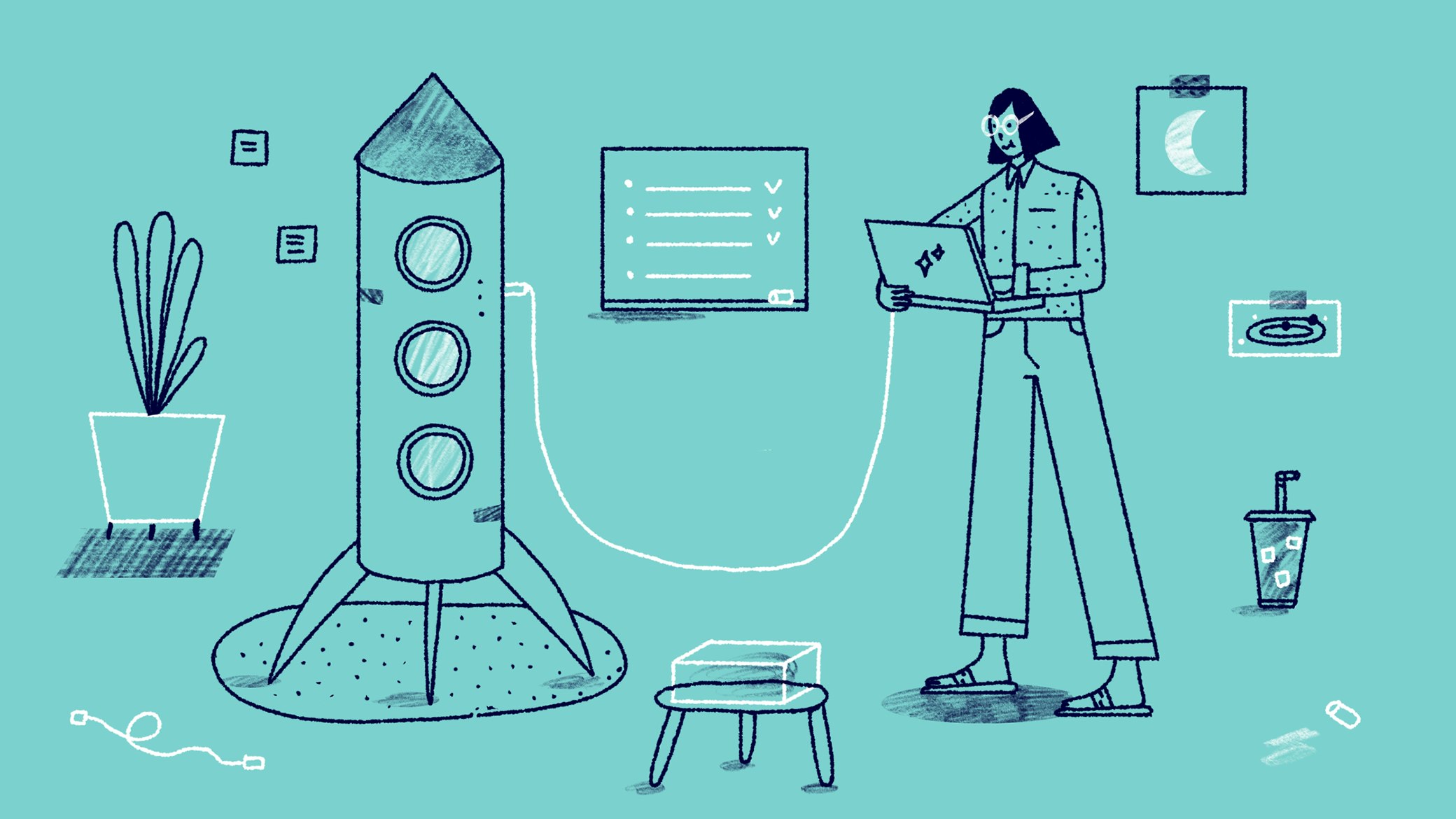The customer onboarding process is probably the most important stage of the customer lifecycle. While it comes right at the start of their journey, it sets the tone for their whole relationship with your product and company.
Customer onboarding has a significant impact on whether a customer keeps using your product long term or churns after just a few months. Done well, it sets your customers up for success and clearly demonstrates the value of your product. Done poorly, it leaves customers questioning why they signed up in the first place.
Below, we’re diving into six crucial steps of your customer onboarding process. You'll find actionable best practices to help you set your newest customers up for success, plus examples from companies with really effective onboarding at each step to inspire you when looking at your own onboarding process.
Customer onboarding is the process that new users go through to get set up and start using your product. It covers the whole journey: from initial sign-up to product activation and first use. Customer onboarding aims to deliver value to your customer as early as possible — in their first use, if possible.
Why is customer onboarding important?
Customer onboarding is so important because it sets the tone for the ongoing relationship your customer has with your product.
A good onboarding process will:
Keep your customers engaged. Helping them clearly understand and experience the value they’ll get from your product will mean they start using it successfully, but more importantly, it’ll give them a reason to log back in and use your product again and again.
Improve trial conversions. If you offer a free or discounted product trial, customer onboarding is where your trial users get to experience the value of your product. If you can demonstrate real value in the onboarding process — right at the start of their trial — you’ll make it more likely they’ll convert into paid customers.
Good customer onboarding sets your customers up to get value from using your product immediately and repeatedly for as long as they continue using it.
The customer onboarding process: Steps, best practices, and examples
Here are six important steps of your customer onboarding process with best practices and tips for each to help you set your newest customers up for long-term success with your product.
1. Sign-up process
It’s tempting to think that customer onboarding doesn’t start until a customer has actually signed up for your product. But we believe the sign-up process is the first step of that journey.
Heap conducted a survey of 79 SaaS companies and found that the average conversion rate for their sign-up process was 36.2%.
While every company is different, if you’re seeing a higher than average drop-off rate (where users start signing up but don’t complete the process), it suggests you’re asking for too much information too soon.
Sign-up process best practices
Keep your sign-up process as short as possible. You want to make it as easy as possible for people to sign up for your product. How much of the information you ask for is nice-to-have rather than essential? Ask for the information that you need to get the customer set up and using your product, then ask for more information later when it’s needed.
Need a lot of information to sign up? Split it over multiple pages rather than asking for everything on one. Heap found that asking for sign-up information across multiple pages correlated with a modest increase in conversion rates. So if you need a lot of information from your customers when they sign up, make it feel like less by splitting it across multiple pages.
Make it easy to sign up with a service they already use, like Google, Slack or social media. This removes almost all the friction from the sign-up process and means new customers can sign up in a single click, which is a huge benefit, according to Heap: “When people have the ability to sign up with one click using a service they already use like Google or Slack, the signup rates improved by 8.2 percentage points.”
Example: Twilio’s sign-up page
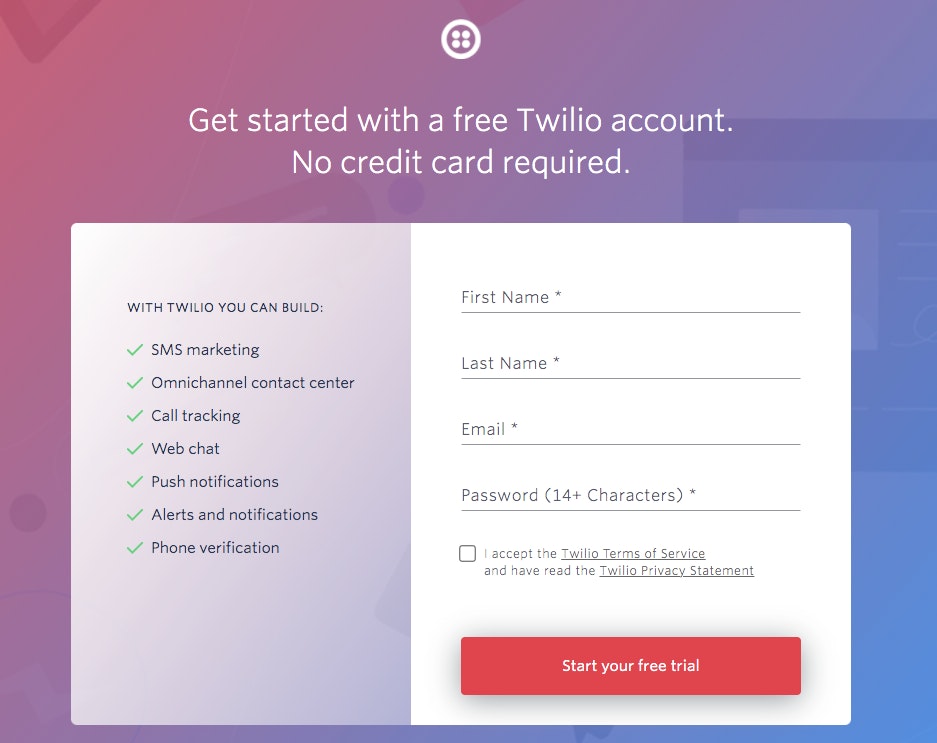
We love:
Short form: It doesn’t ask for lots of information before customers can try out the product.
No credit card required.
Short, scannable bullet points alongside the form, reminding customers of the value they’ll get when they sign up.
Example: Trello’s sign-up page

We love:
There's just one form field to fill out to get started, keeping it as short as possible.
It also gives customers the option to sign up with other tools they already use.
2. Welcome email
After a new customer signs up, the next step in your onboarding process is to send them a welcome email. This email should direct them straight back to your product so they can start using it and getting value from it.
Welcome email best practices
Say thank you! They’ve taken the time to sign up for your product, so it’s important to let your new customers know that you value them.
Share resources that’ll help them get started. This could include a product tour video, links to help center articles, or product FAQs.
Send them back to your product. While it’s helpful to share additional resources, the main focus for your welcome email is to get your new customer to click through and log in to your product. This should be the most prominent link and call-to-action in your welcome email.
Example: Luminary’s welcome email
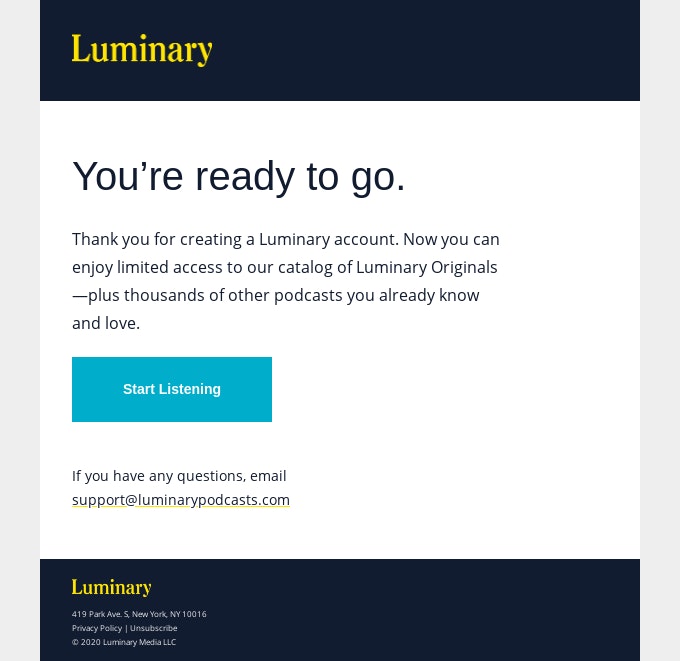
Source: Really Good Emails
We love:
Keeping it short and simple.
A single, prominent call-to-action button to get customers back into the product.
Example: DocSend’s welcome email
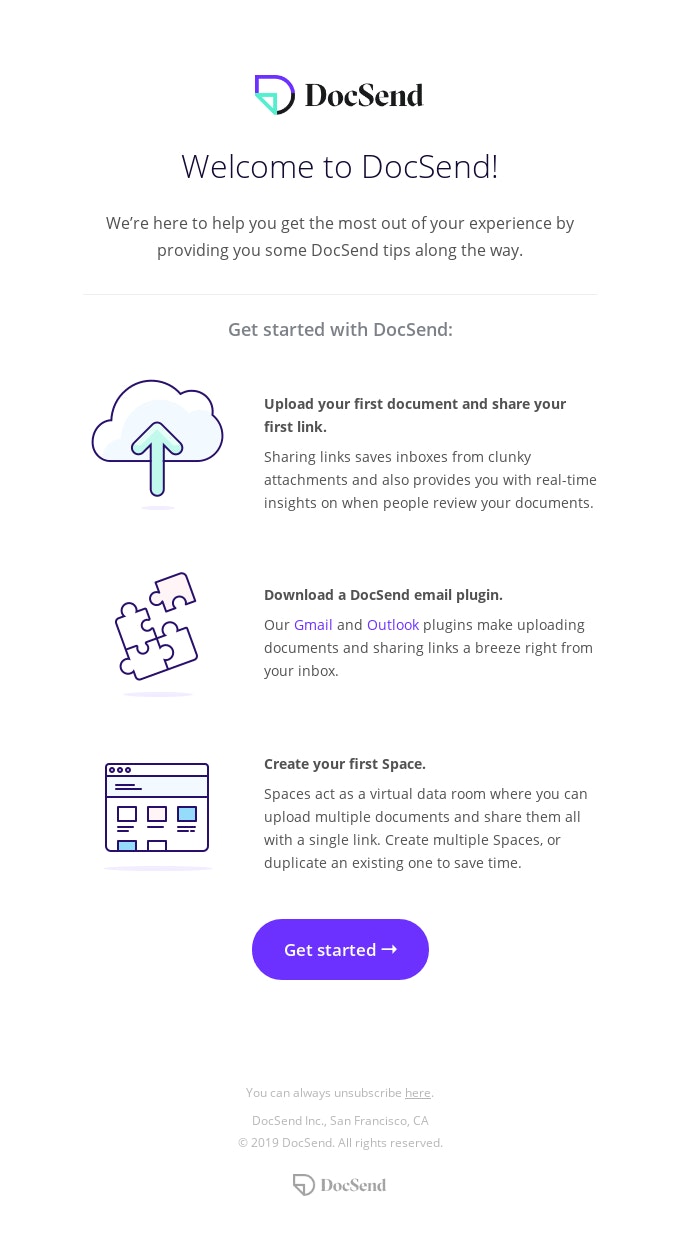
Source: Really Good Emails
We love:
One prominent call-to-action button.
This welcome email teases the start of their onboarding process, sharing three steps the customer will need to take to get started.
3. First log-in
They may have already seen a product demo, watched your product tour, and seen a ton of screenshots. But the first time they log in is your customer’s first real impression of your product.
At this stage, you want to get them set up and ready to start using your product. This normally includes a guided tutorial or set-up wizard to take your customers through each step of the set-up process.
First log-in best practices
Don’t make your customer guess! When they first log in, your new customer shouldn’t find themselves faced with a blank screen. Whether you start off with a welcome pop-up or a set-up wizard, it’s important that you have a way to show your customers around and help them start using your product.
Give your customer a quick win. Getting customers to experience meaningful value from your product requires ongoing activity and engagement. The more they use it, the more value they’ll get from it. But achieving small milestones or quick wins reminds them that they’re heading in the right direction and provides a psychological boost to keep them engaged. This could be as simple as completing your product walkthrough or inviting a colleague to collaborate.
Example: ClearBrain’s first log-in
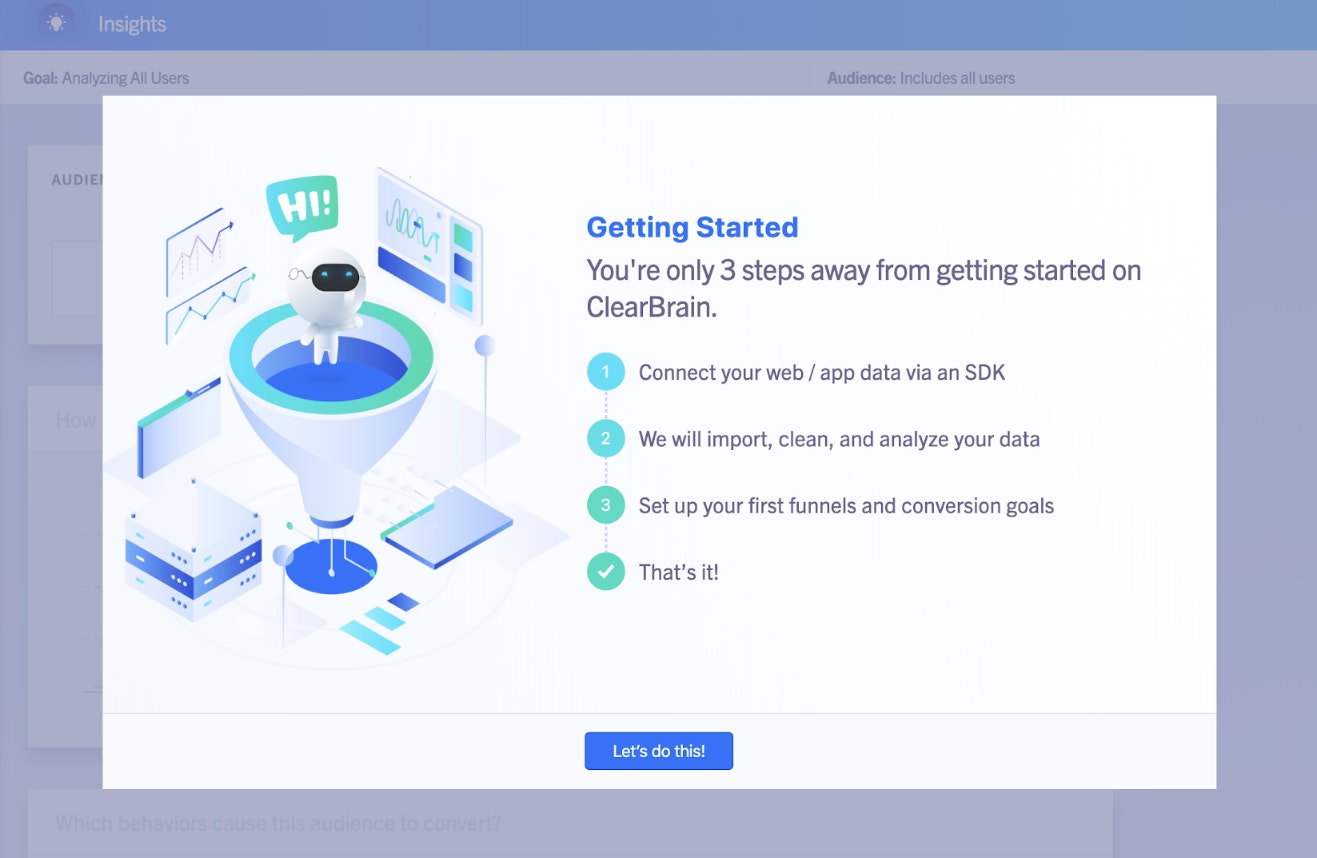
Source: ReallyGoodUX
We love:
This super clear overview of the account set-up process.
Positive, engaging call-to-action copy, motivating the customer to get started.
4. Integrations, invitations, and data imports
For B2B products, the onboarding process likely involves more than simply learning how to use the product. Your product is now part of your customer’s technology stack, and it doesn’t exist in isolation. Customers may need to set up integrations with other tools they use, import data from other sources, or invite their team to get the most value from your product.
Integrations, invitations, and data imports best practices
Automate as much of the process as possible. Setting up an integration between their marketing automation platform and your product — or importing data from one tool to another — can be a challenge. If you can automate as much as possible, it removes any sticking points that might stop the customer from getting value from your product.
Make it optional. Not all your users will need to set up integrations, invite colleagues, or import data from other tools, so don’t make this a compulsory part of the onboarding process.
Provide plenty of support. There’s nothing more frustrating than trying to integrate two tools you use every day and it’s just not working. Many enterprise SaaS companies have a dedicated onboarding team that helps new customers get set up, and data imports and integrations are a crucial part of that role. If you’re not providing a dedicated onboarding service, make it easy for your customers to contact support if they need to.
Example: monday.com’s user invite
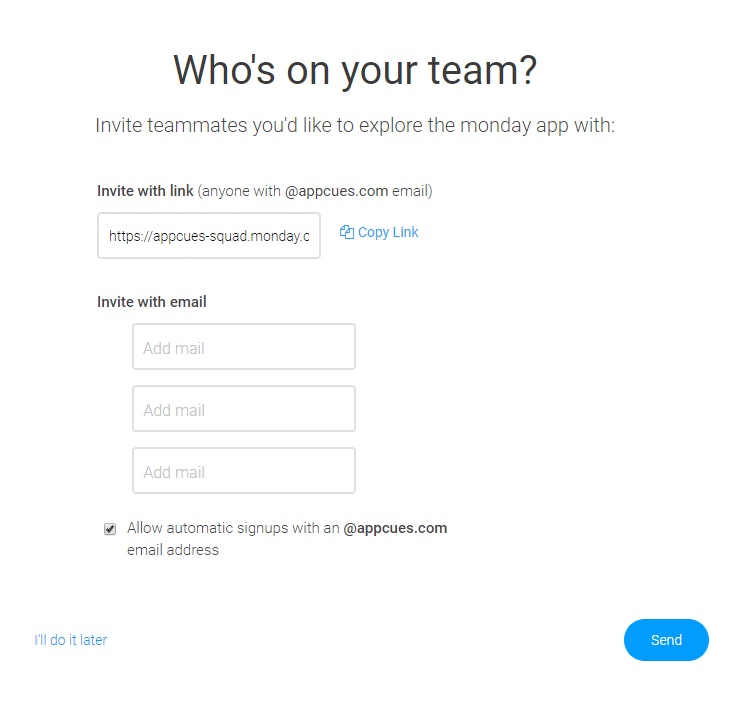
Source: ReallyGoodUX
We love:
This is the last step in the sign-up process. This is appropriate as the customer will experience much more value when using it with their team.
There are two different ways to invite team members — by adding their email or by sharing a link — which makes it easy to invite specific people or to invite a large team all at once.
5. Product walkthrough
A product walkthrough takes your customer through the steps that they need to take in order to get set up and complete key tasks within your product. The easiest and most impactful way for your customers to learn your product is for them to start using the product:
“...walkthroughs stand out because they teach not by showing the user what to do, but by getting the user to actually do.”
Product walkthrough best practices
Make it possible to skip all or part of the walkthrough. Your new customer may already be familiar with your product. Perhaps they used it at a previous job or have seen other people using it a lot. A walkthrough that you can’t skip can be a barrier for customers who seem new but actually aren’t.
Make it easy for people to come back to it later. Not everyone will want to go through a product walkthrough the first time they log in. Make it easy for your new customers to come back to your product walkthrough at a later date — either because they skipped it the first time, or as a useful refresher on different features.
Make it easy for customers to find extra support if they need it. For some users, the walkthrough may not be enough to get them started with your product, and they might need more support. Make sure this is clearly visible and accessible within the walkthrough, for example, by providing contact details for your support team or having a live chat support feature.
Learn more about Help Scout:
6. Follow-up emails
The goal of your onboarding process is to keep your customers engaged so the process doesn’t end after your customer has logged in that first time.
After your welcome email, you may want to send additional follow-up emails, offering tips and pointers to help your customer make use of your product and prompting them to log back in.
Follow-up emails best practices
Share helpful tips and resources. This could be links to your help center, tips on using particular features, or product updates. You want to make sure that each email you send your customer adds value, helps them achieve their goals with your product, and makes them want to log back in.
Share little and often. Sending short follow-up emails more often helps keep your customers engaging with your product and content. It also means you can focus on one feature or use case per email rather than trying to cover lots of subjects in one go and risking confusing your customers.
Consider sharing some social proof. Customer quotes and testimonials aren’t just for marketing. Consider sprinkling in a couple of customer quotes or links to case studies into your follow-up emails. These will remind your customer of the value of your product and what inspired them to sign up in the first place.
Example: Zapier’s follow-up email
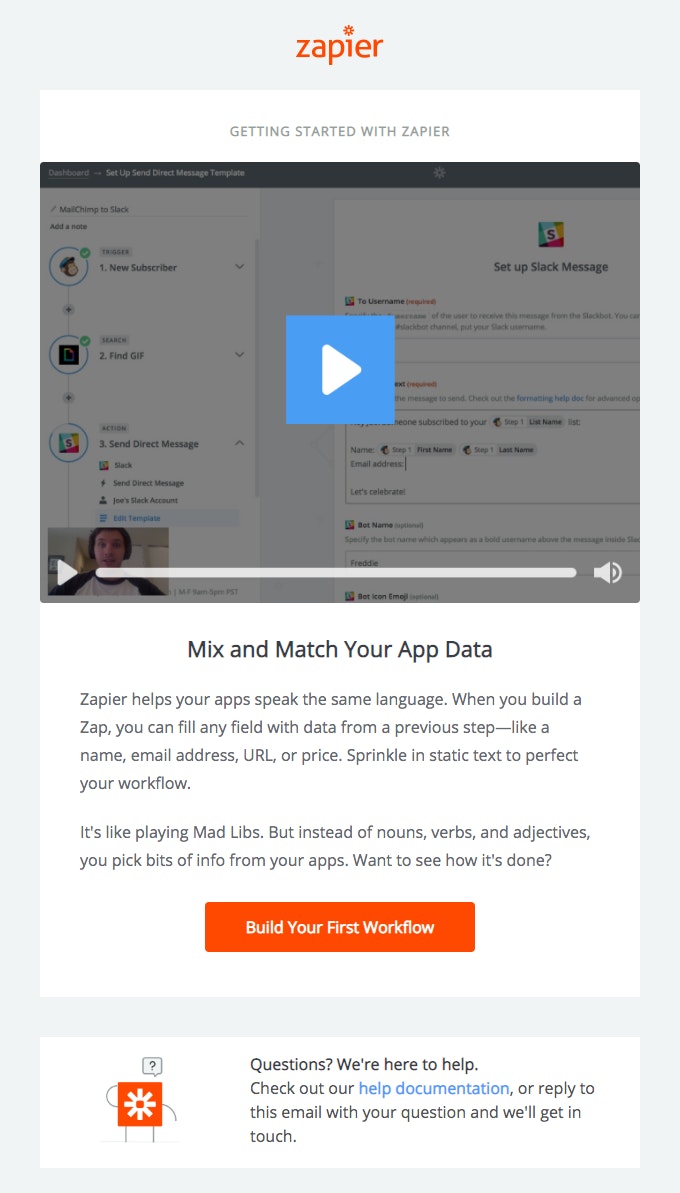
Source: Really Good Emails
We love:
Including a video to engage customers and show them how to get started.
Links to Zapier’s help documentation in case customers need extra support.
One prominent call-to-action button directing them back to the product.
What’s the goal of your customer onboarding process?
Your customer onboarding process comes right at the beginning of your customer journey, but it lays the foundations for your whole relationship. A good customer onboarding process helps not only with customer activation (getting them using your product), but also with customer retention.
It’s easy to think that the main goal of your customer onboarding process is to help your customers start using your product, but it’s so much more than that. The ultimate goal of your onboarding process is to set your customers up for long-term success with your product, right from the very start.
The truest measure of a successful customer onboarding process is whether your customers log back into your product in the days, weeks, and months after that first use.


